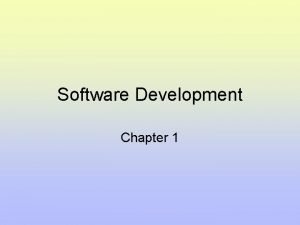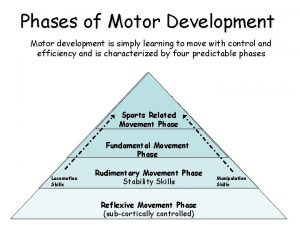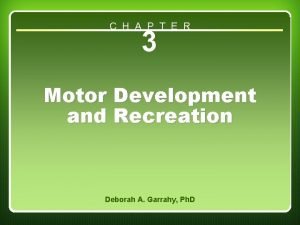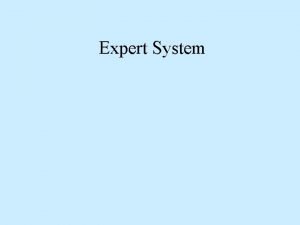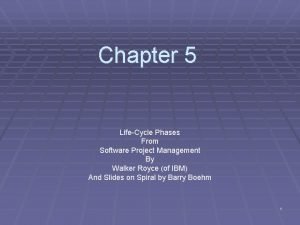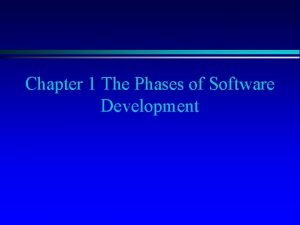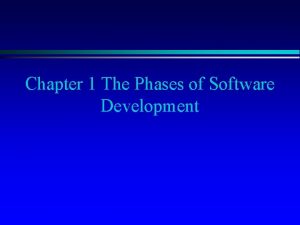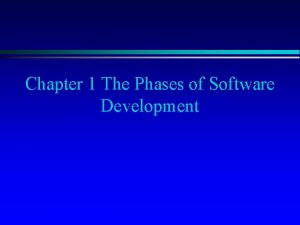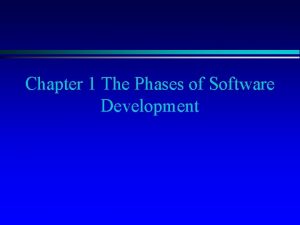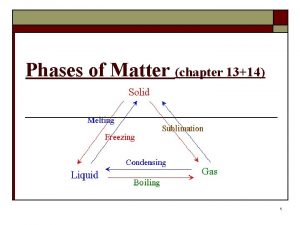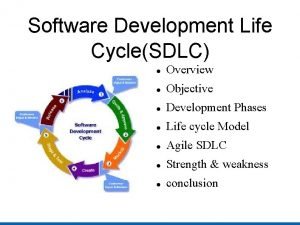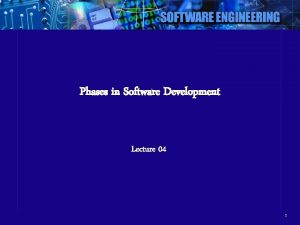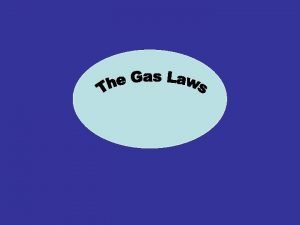Chapter 1 The Phases of Software Development Software

















































- Slides: 49

Chapter 1 The Phases of Software Development

Software Development Phases ● ● ● ● Specification of the task Design of a solution Implementation of solution Analysis of solution Testing and debugging Maintenance and evolution of the system Obsolescence

Specification ● ● Precise description of problem May be one of the most difficult phases

Design ● Algorithm – set of instructions for solving problem ● Not originally done in programming language –pseudocode –Formal ● modeling language (UML) Decompose problem into smaller – more manageable subtasks – map to subprograms –Need to be as independent of each other as possible ● Reuse ● Modification –All domain information should be located only 1 place in the code ● Each subprogram should only do 1 task –Each subprogram should be treated as a black box – specification not implementation – called procedural abstraction / information hiding

Preconditions and Postconditions An important topic: preconditions and postconditions. They are a method of specifying what a function accomplishes. Data Structures and Other Objects Using C++

Preconditions and Postconditions Frequently a programmer must communicate precisely what a function accomplishes, without any indication of how the function does its work. Can you think of a situation where this would occur ?

Example You are the head of a programming team and you want one of your programmers to write a function for part of a project. HERE ARE THE REQUIREMENTS FOR A FUNCTION THAT I WANT YOU TO WRITE. I DON'T CARE WHAT METHOD THE FUNCTION USES, AS LONG AS THESE REQUIREMENTS ARE MET.

What are Preconditions and Postconditions? One way to specify such requirements is with a pair of statements about the function. The precondition statement indicates what must be true before the function is called. The postcondition statement indicates what will be true when the function finishes its work.

Example void write_sqrt(double x) // Precondition: x >= 0. // Postcondition: The square root of x has // been written to the standard output. .

Example void write_sqrt( double x) // Precondition: x >= 0. // Postcondition: The square root of x has // been written to the standard output. The precondition and postcondition appear as comments in your program. . }

Example void write_sqrt( double x) // Precondition: x >= 0. // Postcondition: The square root of x has // been written to the standard output. In this example, the precondition requires that x >= 0 be true whenever the function is called. . }

Example Which of these function calls meet the precondition ? write_sqrt( -10 ); write_sqrt( 5. 6 );

Example Which of these function calls meet the precondition ? write_sqrt( -10 ); write_sqrt( 5. 6 ); The second and third calls are fine, since the argument is greater than or equal to zero.

Example Which of these function calls meet the precondition ? write_sqrt( -10 ); write_sqrt( 5. 6 ); But the first call violates the precondition, since the argument is less than zero.

Example void write_sqrt( double x) // Precondition: x >= 0. // Postcondition: The square root of x has // been written to the standard output. The postcondition always indicates what work the function has accomplished. In this case, when the function returns the square root of x has been written. . }

Another Example bool is_vowel( char letter ) // Precondition: letter is an uppercase or // lowercase letter (in the range 'A'. . . 'Z' or 'a'. . . 'z'). // Postcondition: The value returned by the // function is true if Letter is a vowel; // otherwise the value returned by the function is // false. .

Another Example What values will be returned by these function calls ? is_vowel( 'A' ); is_vowel(' Z' ); is_vowel( '? ' );

Another Example What values will be returned by these function calls ? is_vowel( 'A' ); is_vowel(' Z' ); is_vowel( '? ' ); true false Nobody knows, because the precondition has been violated.

Another Example What values will be returned by these function calls ? is_vowel( '? ' ); Violating the precondition might even crash the computer.

Always make sure the precondition is valid. . . The programmer who calls the function is responsible for ensuring that the precondition is valid when the function is called. AT THIS POINT, MY PROGRAM CALLS YOUR FUNCTION, AND I MAKE SURE THAT THE PRECONDITION IS VALID.

. . . so the postcondition becomes true at the function’s end. The programmer who writes the function counts on the precondition being valid, and ensures that the postcondition becomes true at the function’s end. THEN MY FUNCTION WILL EXECUTE, AND WHEN IT IS DONE, THE POSTCONDITION WILL BE TRUE. I GUARANTEE IT.

A Quiz Suppose that you call a function, and you neglect to make sure that the precondition is valid. Who is responsible if this inadvertently causes a 40 -day flood or other disaster? You The programmer who wrote that torrential function Noah

A Quiz Suppose that you call a function, and you neglect to make sure that the precondition is valid. Who is responsible if this inadvertently causes a 40 -day flood or other disaster? You The programmer who calls a function is responsible for ensuring that the precondition is valid.

On the other hand, careful programmers also follow these rules: When you write a function, you should make every effort to detect when a precondition has been violated. If you detect that a precondition has been violated, then print an error message and halt the program.

On the other hand, careful programmers also follow these rules: When you write a function, you should make every effort to detect when a precondition has been violated. If you detect that a precondition has been violated, then print an error message and halt the program. . . . rather than causing a disaster.

Example void write_sqrt( double x) // Precondition: x >= 0. // Postcondition: The square root of x has // been written to the standard output. { assert(x >= 0); . . . The assert function (described in Section 1. 1) is useful for detecting violations of a precondition.

Advantages of Using Preconditions and Postconditions Succinctly describes the behavior of a function. . . . without cluttering up your thinking with details of how the function works. At a later point, you may reimplement the function in a new way. . . . but programs (which only depend on the precondition/postcondition) will still work with no changes.

Summary Precondition The programmer who calls a function ensures that the precondition is valid. The programmer who writes a function can bank on the precondition being true when the function begins execution. Postcondition The programmer who writes a function ensures that the postcondition is true when the function finishes executing.

C++ Features: Standard Library & Standard Namespace ● #include directive –Similar –Much ● ● ● to import directive in other languages more primitive Namespaces – allows limiting visibility of “names” Standard namespace – standard C++ libraries 2 choices –using namespace std: –Fully qualified identifier

Exception Handling ● Similar to Java and C#

Running Time Analysis ● ● Machine independent method of measuring run time efficiency Determine basic operation for the algorithm Expression the number of operations as a function of the data size Interested in the order of magnitude of this function – expressed using Big-O notation

Running Time Analysis ● ● ● Worst case – maximum number of operations Best case – minimum number of operations Average case – depends upon the underlying probability distribution

The Big-O Notation Analyze algorithm after design Example 50 packages delivered to 50 different houses 50 houses one mile apart, in the same area FIGURE 1 -1 Gift shop and each dot representing a house

The Big-O Notation Example (cont’d. ) Driver picks up all 50 packages Drives one mile to first house, delivers first package Drives another mile, delivers second package Drives another mile, delivers third package, and so on Distance driven to deliver packages 1+1+1+… +1 = 50 miles Total distance traveled: 50 + 50 = 100 miles FIGURE 1 -2 Package delivering scheme

The Big-O Notation Example (cont’d. ) Similar route to deliver another set of 50 packages Driver picks up first package, drives one mile to the first house, delivers package, returns to the shop Driver picks up second package, drives two miles, delivers second package, returns to the shop Total distance traveled 2 * (1+2+3+…+50) = 2550 miles FIGURE 1 -3 Another package delivery scheme

The Big-O Notation Example (cont’d. ) n packages to deliver to n houses, each one mile apart First scheme: total distance traveled 1+1+1+… +n = 2 n miles Function of n Second scheme: total distance traveled 2 * (1+2+3+…+n) = 2*(n(n+1) / 2) = n 2+n Function of n 2

The Big-O Notation TABLE 1 -1 Various values of n, 2 n, n 2, and n 2 + n (n) and (2 n) are close, so we magnify (n) (n 2) and (n 2 + n) are close, so we magnify (n 2)

The Big-O Notation TABLE 1 -1 Various values of n, 2 n, n 2, and n 2 + n When n becomes too large, n and n 2 becomes very different

The Big-O Notation Analyzing an algorithm Count number of operations performed Not affected by computer speed

The Big-O Notation Example 1 -1 Illustrates fixed number of executed operations 1 operation Only one of them will be executed 2 operations 1 operation 3 operations

The Big-O Notation Example 1 -2 Illustrates dominant operations N times the condition is TRUE + 1 time the condition is FALSE 2 operations 1 operation N+1 operations Executed while the cond. is TRUE 2 N operations 3 operations Only one of them will be executed, take the max: 2 1 operation 2 operations 1 operation 3 operation If the while loop executes N times then: 2+1+1+1+5*N + 1 + 3 + 1 + 2 + 3 = 5 N+15

The Big-O Notation How to count for loops 1 op Times the cond. Is TRUE + 1 (when the condition is FALSE for (initialization; condition; increase){ statement 1; Times the cond. statement 2; Is TRUE. . . }

Example 1 op 6 op 5 op for(i=1; i<=5; i++) 5 op 30 op 25 op for(j=1; j<=5; j++) { 25 op cout <<“*”; sum =sum+j; } 25 op Finally: 147 25 op for(i=1; i<=n; i++) for(j=1; j<=n; j++){ cout <<“*”; Sum=sum + j; } 2 n+2+ 2 n 2+2 n+ 3 n 2 = 5 n 2+ 4 n+2

The Big-O Notation TABLE 1 -2 Growth rates of various functions

The Big-O Notation TABLE 1 -3 Time for f(n) instructions on a computer that executes 1 billion instructions per second (1 GHz) Figure 1 -4 Growth rate of functions in Table 1 -3

The Big-O Notation As n becomes larger and larger Term 4 n + 20 in f(n) becomes insignificant Term n 2 becomes dominant term TABLE 1 -4 Growth rate of n 2 and n 2 + 4 n + 20 n

The Big-O Notation Algorithm analysis If function complexity can be described by complexity of a quadratic function without the linear term We say the function is of O(n 2) or Big-O of n 2 Let f and g be real-valued functions Assume f and g nonnegative For all real numbers n, f(n) >= 0 and g(n) >= 0 f(n) is Big-O of g(n): written f(n) = O(g(n)) If there exists positive constants c and n 0 such that f(n) <= cg(n) for all n >= n 0

The Big-O Notation TABLE 1 -5 Some Big-O functions that appear in algorithm analysis

Testing and Debugging ● Good test data –Correct output known –Include values most likely to causes errors Boundary values ● –Fully exercise code Every line of code is executed by at least 1 test case ●
 5 phases of software development
5 phases of software development What does community development mean
What does community development mean Writing stages of development
Writing stages of development Phases of motor development
Phases of motor development 8 phases of sdlc
8 phases of sdlc Phases of curriculum development
Phases of curriculum development Fundamental movement phase
Fundamental movement phase Embedded development life cycle
Embedded development life cycle Startup development phases
Startup development phases Phases of leadership development
Phases of leadership development System analysis and design by kendall
System analysis and design by kendall F
F Stages of expert system life cycle
Stages of expert system life cycle Life cycle phases in software project management
Life cycle phases in software project management Hát kết hợp bộ gõ cơ thể
Hát kết hợp bộ gõ cơ thể Frameset trong html5
Frameset trong html5 Bổ thể
Bổ thể Tỉ lệ cơ thể trẻ em
Tỉ lệ cơ thể trẻ em Voi kéo gỗ như thế nào
Voi kéo gỗ như thế nào Tư thế worm breton là gì
Tư thế worm breton là gì Chúa yêu trần thế
Chúa yêu trần thế Môn thể thao bắt đầu bằng chữ f
Môn thể thao bắt đầu bằng chữ f Thế nào là hệ số cao nhất
Thế nào là hệ số cao nhất Các châu lục và đại dương trên thế giới
Các châu lục và đại dương trên thế giới Công thức tiính động năng
Công thức tiính động năng Trời xanh đây là của chúng ta thể thơ
Trời xanh đây là của chúng ta thể thơ Mật thư anh em như thể tay chân
Mật thư anh em như thể tay chân Làm thế nào để 102-1=99
Làm thế nào để 102-1=99 Phản ứng thế ankan
Phản ứng thế ankan Các châu lục và đại dương trên thế giới
Các châu lục và đại dương trên thế giới Thể thơ truyền thống
Thể thơ truyền thống Quá trình desamine hóa có thể tạo ra
Quá trình desamine hóa có thể tạo ra Một số thể thơ truyền thống
Một số thể thơ truyền thống Cái miệng nó xinh thế chỉ nói điều hay thôi
Cái miệng nó xinh thế chỉ nói điều hay thôi Vẽ hình chiếu vuông góc của vật thể sau
Vẽ hình chiếu vuông góc của vật thể sau Biện pháp chống mỏi cơ
Biện pháp chống mỏi cơ đặc điểm cơ thể của người tối cổ
đặc điểm cơ thể của người tối cổ Thế nào là giọng cùng tên
Thế nào là giọng cùng tên Vẽ hình chiếu đứng bằng cạnh của vật thể
Vẽ hình chiếu đứng bằng cạnh của vật thể Fecboak
Fecboak Thẻ vin
Thẻ vin đại từ thay thế
đại từ thay thế điện thế nghỉ
điện thế nghỉ Tư thế ngồi viết
Tư thế ngồi viết Diễn thế sinh thái là
Diễn thế sinh thái là Dot
Dot Số nguyên là gì
Số nguyên là gì Tư thế ngồi viết
Tư thế ngồi viết Lời thề hippocrates
Lời thề hippocrates Thiếu nhi thế giới liên hoan
Thiếu nhi thế giới liên hoan
